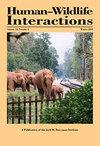南非商业农场上狒狒和黑尾猴的作物觅食行为:减轻损害的初步含义
IF 0.9
4区 环境科学与生态学
Q4 BIODIVERSITY CONSERVATION
引用次数: 12
摘要
种植户与野生非人灵长类动物之间的冲突是一个日益受到关注的世界性保护问题。迄今为止,大多数关于野生灵长类动物作物觅食的研究都集中在与自给农业的冲突上。在大规模商业农业中,灵长类动物觅食造成的作物损害也是人类与野生动物冲突的一个主要方面。尽管其日益严重,但很少有关于农场野生灵长类动物觅食行为的报道,也很少有有效的技术来阻止灵长类动物在商业农场的田间作物。为了解决这一知识差距并确定一些缓解策略,我们使用了从隐藏处直接观察的方法来收集chacma狒狒(Papio ursinus;狒狒)和长尾猴(pygerythrus;2013年,在南非Blouberg区一个564公顷的商业农场,在一公顷的冬南瓜(Cucurbita moschata)地里觅食了4个月(5月至8月)。狒狒对作物造成的破坏最大,它们在早晨更多地觅食作物,它们的作物觅食率主要受自然植被生产力的影响。长尾猴的作物觅食率主要受狒狒存在的影响。当狒狒或黑尾猴访问农场时,一半的访问不涉及作物觅食,黑尾猴在访问时比狒狒更有可能种植饲料。在此初步研究的基础上,我们为农作物种植者提出建议,以提高现有威慑方法的有效性。这些措施包括,当自然植被下降到标准化植被指数差值0.32以下时,特别是在中午前的几个小时,加大威慑力度,在离农场更远的地方追逐狒狒和长尾鼠,而不仅仅是在农田外,并增加田间警卫的感知死亡风险。在更广泛地采用这些建议之前,应对这些建议进行评价,以确定其有效性。本文章由计算机程序翻译,如有差异,请以英文原文为准。
Baboon and Vervet Monkey Crop-Foraging Behaviors on a Commercial South African Farm: Preliminary Implications for Damage Mitigation
Conflict between crop farmers and wild nonhuman primates is a worldwide conservation issue of increasing concern. Most of the research on wild primate crop foraging has so far focused on the conflicts with subsistence agriculture. Crop damage caused by primate foraging in large-scale commercial agriculture is also a major facet of human–wildlife conflict. Despite its increasing severity, there are very few published accounts of on-farm wild primate crop-foraging behavior or effective techniques to deter primates from field crops on commercial farms. To address this knowledge gap and identify some mitigation strategies, we used direct observation from a hide to collect behaviors and interspecific interactions between chacma baboons (Papio ursinus; baboons) and vervet monkeys (Chlorocebus pygerythrus; vervets) foraging in a 1-ha butternut squash (Cucurbita moschata) field for 4 months (May to August) in 2013 on a 564-ha commercial farm in the Blouberg District of South Africa. Baboons caused the most crop damage, foraged on crops more in the mornings, and their rates of crop foraging were influenced primarily by natural vegetation productivity. Vervet monkey rates of crop foraging were primarily influenced by the presence of baboons. When baboons or vervets visited the farm, half of the visits did not involve crop foraging, and vervets were more likely to crop forage when they visited than baboons. Based on this preliminary study, we make recommendations for crop farmers to improve the effectiveness of current deterrent methods. These include increasing deterrent efforts when natural vegetation drops below a normalized difference vegetation index value of 0.32, especially during the hours before midday, chasing baboons and vervets farther from the farm rather than just out of crop fields, and increasing the perceived mortality risk of field guards. These recommendations should be evaluated to determine effectiveness before being adopted on a wider scale.
求助全文
通过发布文献求助,成功后即可免费获取论文全文。
去求助
来源期刊

Human–Wildlife Interactions
Environmental Science-Nature and Landscape Conservation
CiteScore
2.80
自引率
0.00%
发文量
0
审稿时长
11 weeks
期刊介绍:
Human–Wildlife Interactions (HWI) serves the professional needs of the wildlife biologist and manager in the arena of human–wildlife conflicts/interactions, wildlife damage management, and contemporary wildlife management. The intent of HWI is to publish original contributions on all aspects of contemporary wildlife management and human–wildlife interactions with an emphasis on scientific research and management case studies that identify and report innovative conservation strategies, technologies, tools, and partnerships that can enhance human–wildlife interactions by mitigating human–wildlife conflicts through direct and indirect management of wildlife and increased stakeholder engagement. Our intent is to promote a dialogue among wildlife professionals concerning contemporary management issues. As such, we hope to provide a repository for wildlife management science and case studies that document and share manager experiences and lessons learned.
 求助内容:
求助内容: 应助结果提醒方式:
应助结果提醒方式:


